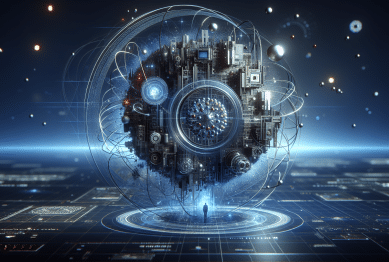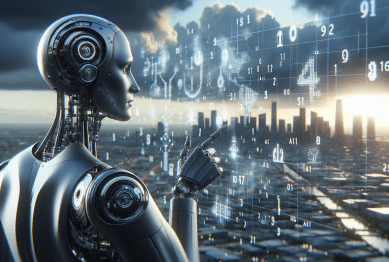Artificial intelligence is shaping the future of technology and everyday life in unexpected ways. This guide uncovers how AI affects daily routines, industry advances, and privacy concerns, giving you a clear picture of its growing role in society and what to consider as this technology evolves rapidly.
Understanding Artificial Intelligence in Everyday Life
Artificial intelligence (AI) is no longer just a futuristic concept from movies. It’s now part of daily life, often in ways you don’t even notice. AI systems analyze your streaming habits to suggest new shows, help power voice assistants on smartphones, and support navigation apps. Many people wonder how AI quietly shapes choices every day. With technologies like natural language processing and machine learning built into online search engines and personal devices, artificial intelligence has quickly become woven into common experiences. Whether you’re using an app to translate languages or receiving personalized recommendations online, AI is hard at work behind the scenes, increasing both convenience and efficiency.
Recommendations on e-commerce platforms are just one surface-level example. Beneath the obvious, AI is transforming essential services. Online banking uses advanced algorithms to detect possible fraud by monitoring patterns in your spending. Email filters leverage these technologies to spot and remove spam. Even public transportation systems use intelligent routing to improve efficiency and reduce congestion. With smart devices connected throughout homes, AI can learn preferences, adjusting settings like lighting or temperature for comfort. The integration feels seamless, but the scale of data analysis happening in the background is vast. You interact with dozens of AI-driven systems each week without consciously thinking about it.
This widespread adoption of artificial intelligence means it’s important to understand how your data gets used. There’s more than efficiency at play. Privacy and ethical considerations grow as AI decisions become more influential. The use of facial recognition at airports, automated decision-making in hiring, and intelligent health monitoring devices all show the reach of AI today. Society is moving toward a future where such systems will become even more deeply embedded. Reflecting on how and why these systems are used can help guide more informed choices about privacy and digital habits.
The Rapid Growth of Machine Learning Applications
Machine learning, an essential component of AI, is the driving force behind much of artificial intelligence’s adaptability. By learning from data rather than being explicitly programmed, machine learning models enable computers to spot patterns, anticipate needs, and even make predictions. Many industries rely on this technology to automate complex tasks. Healthcare organizations identify early signs of illness, financial platforms monitor for unusual transactions, and smart cities use predictive analytics for energy efficiency. Each time new data appears, algorithms can adjust their responses, often making invisible but impactful decisions.
Perhaps even more remarkable is how quickly these systems are evolving. Self-driving vehicles use computer vision and real-time learning to navigate changing road conditions. In customer support, AI-powered chatbots now understand conversational context, empowering them to resolve problems without human intervention. Social media networks employ content moderation tools to flag inappropriate material before it spreads. All these advances are possible thanks to continuous model training, fueled by huge volumes of data and robust computational power. The speed of change makes it crucial for the public to stay informed about evolving uses of artificial intelligence.
Machine learning doesn’t only power headline-grabbing innovations; it affects small-scale, routine tasks as well. Grammar-checking apps highlight errors in real-time, while streaming platforms suggest content you might enjoy based on your viewing history. Even weather forecasts benefit from increasingly precise simulations. It’s easy to overlook how these systems simplify daily tasks, but the cumulative impact of AI-driven personalization and efficiency is substantial. As machine learning capabilities grow, their influence on decisions—big and small—will expand across every sector.
How Data Privacy Is Shaped by Artificial Intelligence
AI systems rely on vast pools of personal and collective data to deliver precise results. This dependence on data collection sparks ongoing debate about privacy. Every time a device listens for a voice command, records an online purchase, or scans a face for security, digital records are stored and processed. Increasingly sophisticated algorithms extract insights from seemingly harmless behaviors, raising questions about who owns this data and how it might be used now or in the future.
Many leading organizations, as well as governments, have responded by enforcing regulations to safeguard privacy. The General Data Protection Regulation (GDPR) in the European Union and other similar laws worldwide require transparency in data handling and give users more control. AI developers are also increasingly adopting privacy-by-design approaches, ensuring sensitive details are protected from the outset. These innovations include differential privacy, where data is anonymized to maintain confidentiality, and secure multi-party computation that allows joint analysis without sharing raw information.
Yet, privacy remains an evolving challenge as artificial intelligence systems grow more powerful. With devices such as smart speakers and wearable trackers regularly collecting personal data, users need to remain aware of disclosure. The balance between convenience and caution is complex. Educating yourself about privacy settings, understanding the ethical implications of AI, and monitoring policy changes can help make technology safer and more user-centric over time. The transparency of AI decisions—and the ways organizations explain them—is also becoming essential in building public trust.
AI’s Influence on Job Markets and Workplace Dynamics
AI’s rapid advancement is sparking changes within the workplace. Automated processes handle repetitive or hazardous tasks, freeing employees to focus on creativity and complex problem-solving. Robotics in manufacturing, algorithms in logistics, and intelligent scheduling systems are already improving productivity. As many roles evolve, learning new digital skills is becoming vital. Not only do these changes enhance efficiency in the workplace, but they open new opportunities for those ready to adapt.
The rise of artificial intelligence also brings challenges. Some positions are at risk of becoming obsolete as automation increases. This shifts the focus toward retraining programs and adaptable career pathways. Governments and educational institutions are devising programs to help workers develop competencies in data science, cybersecurity, and AI management. These changes foster ongoing debate about the human impact of technology. It’s not just blue-collar jobs affected; creative, administrative, and technical fields are being redefined through increasing collaboration with advanced AI systems.
Despite uncertainty, AI is creating novel professions. Machine learning engineers, data ethicists, and AI auditors are new roles emerging in response to society’s demand for accountability and transparency. Companies using AI encourage lifelong learning and upskilling for employees to keep pace with technological progress. Overall, artificial intelligence is less about replacing humans and more about reshaping the nature of work. Those who approach these changes proactively will find opportunities for professional growth and security as new technologies mature.
Exploring Ethical Considerations and Accountability in AI
The power of AI brings critical ethical questions to the surface. Who is responsible when an algorithm makes a harmful decision? How can the risk of embedded bias be reduced when data is collected from real-world sources? These issues are at the core of many public discussions around AI. Transparent, explainable AI is a growing area of focus as companies strive to ensure decisions are understandable and can be audited for fairness. The development of guidelines and oversight groups may help prevent misuse and foster public trust.
One key debate centers around bias in AI. Algorithms trained on incomplete or unrepresentative data may perpetuate existing social inequalities. For example, AI used in hiring or law enforcement can inadvertently reinforce disparities unless robust safeguards are in place. Addressing these risks demands collaboration between technologists, legal experts, and ethicists. Some organizations provide open access to their AI code and decision-making criteria, empowering outside scrutiny. These efforts support the development of fairer, more inclusive technologies.
Accountability is also top of mind as AI applications become more embedded in sensitive areas like healthcare and autonomous transportation. Establishing clear oversight mechanisms and continuing to evaluate the societal impact of innovations is essential. Many experts recommend designing AI solutions that can explain their decisions to users and stakeholders. As artificial intelligence helps solve complex problems, these ethical considerations will grow in importance, outlining how technology can be integrated thoughtfully for everyone’s benefit.
Preparing for a Future with Intelligent Machines
With the pace of AI development accelerating, preparing for a future with intelligent machines requires both curiosity and caution. Embracing the benefits of automation, efficiency, and decision support calls for an open mind and ongoing learning. Staying informed about trends—like advances in neural networks or new uses of robotics—can spark excitement about future opportunities. The more you understand how these systems operate, the easier it becomes to harness their potential.
Education will play a vital role in readiness for this AI-enabled world. Institutions at every level are investing in coursework focused on computer science, critical thinking, and ethical AI. Many leading technology organizations offer free and accessible resources to build digital skills. These programs are designed not only for tech professionals but for anyone interested in understanding modern systems. As self-guided learning gains traction, more individuals will recognize the value of lifelong adaptability in the digital economy.
Alongside education, staying engaged in policy discussions around artificial intelligence is increasingly important. Informed citizens shape legislation, advocate for responsible use, and challenge misapplications. Supporting transparent governance and demanding ethical standards helps ensure innovation remains a force for good. With the right approach, AI can drive progress across every area of society—giving everyone the opportunity to explore what’s possible with intelligent machines as a trusted companion, not just a tool.
References
1. European Union. (n.d.). General Data Protection Regulation (GDPR) Compliance Guidelines. Retrieved from https://gdpr.eu
2. Harvard University. (n.d.). Artificial Intelligence: Implications for Business Strategy. Retrieved from https://online.hbs.edu
3. Stanford University. (n.d.). Artificial Intelligence and Life in 2030: One Hundred Year Study on Artificial Intelligence. Retrieved from https://ai100.stanford.edu
4. Future of Life Institute. (n.d.). Benefits & Risks of Artificial Intelligence. Retrieved from https://futureoflife.org/background/benefits-risks-of-artificial-intelligence/
5. Pew Research Center. (n.d.). Artificial Intelligence and the Future of Humans. Retrieved from https://www.pewresearch.org/internet/2021/06/21/artificial-intelligence-and-the-future-of-humans/
6. United Nations Educational, Scientific and Cultural Organization (UNESCO). (n.d.). Recommendation on the Ethics of Artificial Intelligence. Retrieved from https://unesdoc.unesco.org/ark:/48223/pf0000379920









